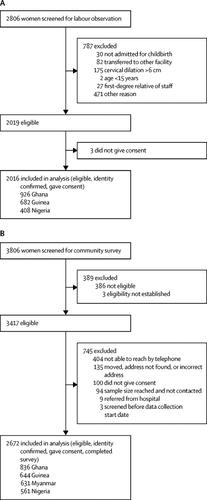Our official English website, www.x-mol.net, welcomes your
feedback! (Note: you will need to create a separate account there.)
How women are treated during facility-based childbirth in four countries: a cross-sectional study with labour observations and community-based surveys.
The Lancet ( IF 98.4 ) Pub Date : 2019-10-08 , DOI: 10.1016/s0140-6736(19)31992-0 Meghan A Bohren 1 , Hedieh Mehrtash 2 , Bukola Fawole 3 , Thae Maung Maung 4 , Mamadou Dioulde Balde 5 , Ernest Maya 6 , Soe Soe Thwin 2 , Adeniyi K Aderoba 7 , Joshua P Vogel 8 , Theresa Azonima Irinyenikan 9 , A Olusoji Adeyanju 10 , Nwe Oo Mon 4 , Kwame Adu-Bonsaffoh 11 , Sihem Landoulsi 2 , Chris Guure 12 , Richard Adanu 13 , Boubacar Alpha Diallo 5 , A Metin Gülmezoglu 2 , Anne-Marie Soumah 5 , Alpha Oumar Sall 5 , Özge Tunçalp 2
The Lancet ( IF 98.4 ) Pub Date : 2019-10-08 , DOI: 10.1016/s0140-6736(19)31992-0 Meghan A Bohren 1 , Hedieh Mehrtash 2 , Bukola Fawole 3 , Thae Maung Maung 4 , Mamadou Dioulde Balde 5 , Ernest Maya 6 , Soe Soe Thwin 2 , Adeniyi K Aderoba 7 , Joshua P Vogel 8 , Theresa Azonima Irinyenikan 9 , A Olusoji Adeyanju 10 , Nwe Oo Mon 4 , Kwame Adu-Bonsaffoh 11 , Sihem Landoulsi 2 , Chris Guure 12 , Richard Adanu 13 , Boubacar Alpha Diallo 5 , A Metin Gülmezoglu 2 , Anne-Marie Soumah 5 , Alpha Oumar Sall 5 , Özge Tunçalp 2
Affiliation

|
BACKGROUND
Women across the world are mistreated during childbirth. We aimed to develop and implement evidence-informed, validated tools to measure mistreatment during childbirth, and report results from a cross-sectional study in four low-income and middle-income countries.
METHODS
We prospectively recruited women aged at least 15 years in twelve health facilities (three per country) in Ghana, Guinea, Myanmar, and Nigeria between Sept 19, 2016, and Jan 18, 2018. Continuous observations of labour and childbirth were done from admission up to 2 h post partum. Surveys were administered by interviewers in the community to women up to 8 weeks post partum. Labour observations were not done in Myanmar. Data were collected on sociodemographics, obstetric history, and experiences of mistreatment.
FINDINGS
2016 labour observations and 2672 surveys were done. 838 (41·6%) of 2016 observed women and 945 (35·4%) of 2672 surveyed women experienced physical or verbal abuse, or stigma or discrimination. Physical and verbal abuse peaked 30 min before birth until 15 min after birth (observation). Many women did not consent for episiotomy (observation: 190 [75·1%] of 253; survey: 295 [56·1%] of 526) or caesarean section (observation: 35 [13·4%] of 261; survey: 52 [10·8%] of 483), despite receiving these procedures. 133 (5·0%) of 2672 women or their babies were detained in the facility because they were unable to pay the bill (survey). Younger age (15-19 years) and lack of education were the primary determinants of mistreatment (survey). For example, younger women with no education (odds ratio [OR] 3·6, 95% CI 1·6-8·0) and younger women with some education (OR 1·6, 1·1-2·3) were more likely to experience verbal abuse, compared with older women (≥30 years), adjusting for marital status and parity.
INTERPRETATION
More than a third of women experienced mistreatment and were particularly vulnerable around the time of birth. Women who were younger and less educated were most at risk, suggesting inequalities in how women are treated during childbirth. Understanding drivers and structural dimensions of mistreatment, including gender and social inequalities, is essential to ensure that interventions adequately account for the broader context.
FUNDING
United States Agency for International Development and the UNDP/UNFPA/UNICEF/WHO/World Bank Special Programme of Research, Development and Research Training in Human Reproduction, Department of Reproductive Health and Research, WHO.
中文翻译:

四个国家/地区的妇女在设施分娩期间受到的待遇:一项包含分娩观察和社区调查的横断面研究。
背景世界各地的妇女在分娩期间受到虐待。我们旨在开发和实施循证、经过验证的工具来衡量分娩期间的虐待情况,并报告在四个低收入和中等收入国家进行的横断面研究的结果。方法 我们在 2016 年 9 月 19 日至 2018 年 1 月 18 日期间在加纳、几内亚、缅甸和尼日利亚的 12 家医疗机构(每个国家 3 家)前瞻性招募了至少 15 岁的女性。从入院开始对分娩和分娩进行持续观察最多产后 2 小时。调查由社区的访谈员对产后 8 周内的女性进行。缅甸没有进行劳工观察。收集了有关社会人口统计学、产科病史和虐待经历的数据。结果 完成了 2016 年劳动观察和 2672 项调查。2016 年有 838 名 (41·6%) 的女性遭受过身体或言语虐待、污名或歧视,2672 名接受调查的女性中有 945 名 (35·4%) 遭受过身体或语言虐待。身体和言语虐待在出生前 30 分钟达到峰值,直到出生后 15 分钟(观察)。许多女性不同意会阴切开术(观察:253 人中的 190 人 [75·1%];调查:526 人中的 295 人 [56·1%])或剖腹产(观察:261 人中的 35 人 [13·4%];调查: 52 [10·8%] of 483),尽管接受了这些程序。2672 名妇女或其婴儿中有 133 人 (5·0%) 因无法支付账单而被拘留在该设施中(调查)。年龄较小(15-19 岁)和缺乏教育是虐待的主要决定因素(调查)。例如,没有受过教育的年轻女性(优势比 [OR] 3·6,95% CI 1·6-8·0) 和受过一定教育的年轻女性 (OR 1·6, 1·1-2·3) 与年长女性(≥30 岁)相比,更有可能遭受言语虐待,调整婚姻状况和平等。解释 超过三分之一的妇女经历过虐待,在分娩前后尤其容易受到伤害。年龄较小且受教育程度较低的妇女面临的风险最大,这表明妇女在分娩期间受到的待遇存在不平等。了解虐待的驱动因素和结构层面,包括性别和社会不平等,对于确保干预措施充分考虑更广泛的背景至关重要。资助美国国际开发署和 UNDP/UNFPA/UNICEF/WHO/World Bank 人类生殖研究、发展和研究培训特别规划,
更新日期:2019-11-08
中文翻译:

四个国家/地区的妇女在设施分娩期间受到的待遇:一项包含分娩观察和社区调查的横断面研究。
背景世界各地的妇女在分娩期间受到虐待。我们旨在开发和实施循证、经过验证的工具来衡量分娩期间的虐待情况,并报告在四个低收入和中等收入国家进行的横断面研究的结果。方法 我们在 2016 年 9 月 19 日至 2018 年 1 月 18 日期间在加纳、几内亚、缅甸和尼日利亚的 12 家医疗机构(每个国家 3 家)前瞻性招募了至少 15 岁的女性。从入院开始对分娩和分娩进行持续观察最多产后 2 小时。调查由社区的访谈员对产后 8 周内的女性进行。缅甸没有进行劳工观察。收集了有关社会人口统计学、产科病史和虐待经历的数据。结果 完成了 2016 年劳动观察和 2672 项调查。2016 年有 838 名 (41·6%) 的女性遭受过身体或言语虐待、污名或歧视,2672 名接受调查的女性中有 945 名 (35·4%) 遭受过身体或语言虐待。身体和言语虐待在出生前 30 分钟达到峰值,直到出生后 15 分钟(观察)。许多女性不同意会阴切开术(观察:253 人中的 190 人 [75·1%];调查:526 人中的 295 人 [56·1%])或剖腹产(观察:261 人中的 35 人 [13·4%];调查: 52 [10·8%] of 483),尽管接受了这些程序。2672 名妇女或其婴儿中有 133 人 (5·0%) 因无法支付账单而被拘留在该设施中(调查)。年龄较小(15-19 岁)和缺乏教育是虐待的主要决定因素(调查)。例如,没有受过教育的年轻女性(优势比 [OR] 3·6,95% CI 1·6-8·0) 和受过一定教育的年轻女性 (OR 1·6, 1·1-2·3) 与年长女性(≥30 岁)相比,更有可能遭受言语虐待,调整婚姻状况和平等。解释 超过三分之一的妇女经历过虐待,在分娩前后尤其容易受到伤害。年龄较小且受教育程度较低的妇女面临的风险最大,这表明妇女在分娩期间受到的待遇存在不平等。了解虐待的驱动因素和结构层面,包括性别和社会不平等,对于确保干预措施充分考虑更广泛的背景至关重要。资助美国国际开发署和 UNDP/UNFPA/UNICEF/WHO/World Bank 人类生殖研究、发展和研究培训特别规划,











































 京公网安备 11010802027423号
京公网安备 11010802027423号